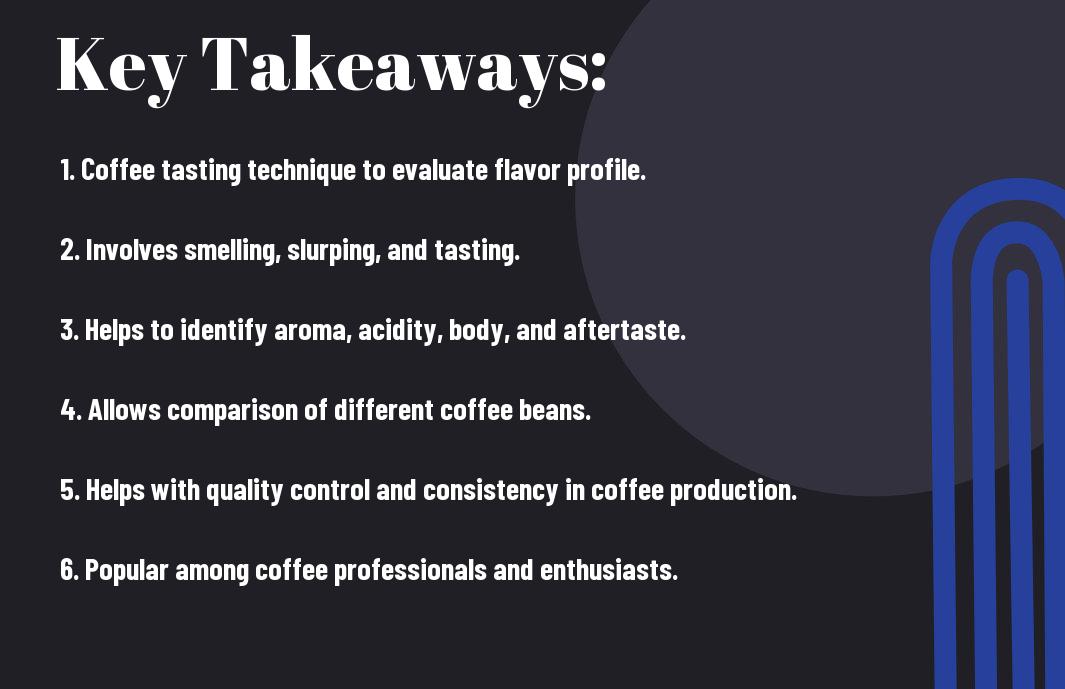Many coffee enthusiasts are familiar with the term “coffee cupping,” but what exactly does it entail? In this informative post, we will research into the world of coffee cupping, exploring its origins, the process involved, and why it is an necessary practice for coffee professionals and aficionados alike. So grab your favorite mug and join us on a sensory journey through the art of coffee cupping.
Key Takeaways:
- Coffee cupping is a professional practice used to evaluate different coffee beans for their flavor, aroma, and overall quality.
- Cupping involves a structured process of grinding coffee, smelling the grounds, adding hot water, breaking the crust, and finally tasting the brewed coffee.
- Participating in a coffee cupping can help coffee enthusiasts develop their palate, identify flavor profiles, and appreciate the nuances of various coffees.

Defining Coffee Cupping
Your journey into the world of coffee cupping begins with understanding its origins and history.
Origins and History
Defining coffee cupping dates back to the ancient coffee trade practices of the 9th-century coffee markets in the Middle East. Merchants would sample their coffee shipments by steeping the beans in hot water to assess the quality before finalizing a sale. This process evolved over time, and in the 20th century, cupping became a formalized practice used by roasters, baristas, and coffee enthusiasts worldwide to evaluate and appreciate the nuanced flavors of coffee beans.
The Science Behind Cupping
Coffee cupping goes beyond a mere taste test; it is a sensory experience that examines into the intricate science behind coffee flavor profiles. During cupping, participants evaluate the coffee’s aroma, acidity, body, and flavor notes through a standardized process that involves sniffing, slurping, and spitting. This method allows them to discern subtle differences and complexities in various coffees, highlighting the unique characteristics of each bean.
Coffee cupping is a sensory journey that engages the taste buds, sense of smell, and even touch to explore the diverse world of coffee flavors. For instance, participants may detect floral undertones, fruity notes, or hints of chocolate in their cupping samples, enhancing their appreciation for the art and science of coffee tasting.


The Cupping Process
There’s an art to the coffee cupping process, a methodical and sensory experience that allows coffee enthusiasts to evaluate and appreciate the intricate flavors and aromas of different coffee beans. If you want to dive deeper into the world of coffee cupping, check out this insightful article on What Is Coffee Cupping?.
Preparation and Equipment
On the day of the cupping, the coffee beans are ground to a specific coarseness and placed in individual cups. Boiling water is then poured over the grounds, allowing them to steep before breaking the crust that forms on the surface. Special cupping spoons are used to taste the coffee, and a spittoon is provided for spitting out samples to prevent over-caffeination.
Evaluating Flavor and Aroma
Aroma plays a crucial role in the coffee cupping experience, as the fragrances released during the “breaking of the crust” can reveal a whole new dimension of the coffee’s character. Participants inhale deeply to capture notes of floral, fruity, earthy, or spicy aromas, preparing their palate for the upcoming tasting.
Aroma and flavor are closely intertwined during the cupping process. The first sip of the coffee results in a slurp — a loud, aerating slurp that spreads the coffee across the palate, enhancing the tasting experience and allowing all flavor receptors to be engaged.
Noting Acidity and Body
Flavor exploration continues as cuppers focus on noting the acidity and body of the coffee. Acidity refers to the bright, tangy notes that add liveliness to the coffee’s profile, while body describes the weight and texture of the brew in the mouth. By evaluating these aspects, cuppers can fully grasp the complexity and quality of the coffee beans.
In the evaluation of acidity and body, acidity is often described in terms of citrusy, fruity, or wine-like qualities, whereas body can be characterized as light, medium, or full. These attributes contribute significantly to the overall balance and mouthfeel of the coffee.
The coffee cupping process provides a holistic approach to understanding the nuances of coffee flavors, aromas, acidity, and body. By engaging all senses and employing a structured evaluation method, participants can appreciate the diversity and richness of the coffee world in a single cupping session.
Coffee Cupping Techniques
After understanding the basics of coffee cupping, it’s vital to examine the various techniques used to evaluate and appreciate different coffee profiles. These techniques can be broadly classified into traditional methods, modern approaches, and expert tips and tricks.
Traditional Methods
Traditional coffee cupping involves a standardized process of evaluating coffee based on aroma, flavor, acidity, body, and aftertaste. The coffee grounds are steeped in hot water, allowing the coffee to brew before breaking the crust that forms on the surface to release aromas.
Modern Approaches
For instance, modern coffee cupping may involve using specialized equipment like refractometers to measure the coffee’s extraction levels precisely. The use of technology has allowed for more accurate and consistent evaluations of coffee characteristics, providing valuable insights for roasters and baristas.
An vital aspect of modern approaches to coffee cupping is the emphasis on sustainability and ethical sourcing practices. This includes evaluating the environmental and social impact of coffee production, fostering a more holistic understanding of the coffee supply chain.
Expert Tips and Tricks
- Analyze the aroma of the dry grounds before adding water to assess the coffee’s fragrance potential.
- Pay attention to the coffee’s temperature to gauge its flavor profile accurately.
Recognizing the nuances and subtleties in coffee flavors requires practice and a keen palate. Experienced cuppers often rely on their sensory memory and reference samples to make informed judgments about different coffees.
The key to mastering coffee cupping lies in consistent practice and a willingness to experiment with different techniques. By honing your sensory skills and understanding the factors that influence coffee quality, you can develop a deeper appreciation for the world of specialty coffee.
Coffee Cupping Terminology
Despite the seemingly simple act of sipping a brewed coffee, the art of coffee cupping involves a whole world of terminology to describe the intricate flavors and aromas found in different coffee beans. Understanding some key terms used in coffee cupping can enhance your appreciation of the complexities of this beloved beverage.
Describing Flavor Profiles
An vital aspect of coffee cupping is the ability to pinpoint and describe various flavor profiles present in the coffee. Terms like fruity, floral, nutty, spicy, or earthy are commonly used to capture the nuanced tastes that different coffees offer. The ability to articulate these flavor notes not only adds depth to the cupping experience but also helps in distinguishing between various coffee origins and processing methods.
Understanding Coffee Acidity
To fully appreciate a coffee’s acidity, one must keep in mind that acidity in coffee is not a measure of the pH level but rather a sensory experience. Acidity refers to the liveliness and brightness that a coffee possesses, which can range from crisp and vibrant to mellow and subtle. Acidity adds complexity to the coffee’s flavor profile and contributes to its overall balance.
Flavor
Identifying Body and Mouthfeel
Body and mouthfeel are two terms often used in coffee cupping to describe the weight, texture, and consistency of the brewed coffee. Body refers to the perceived heaviness or thickness of the coffee on the palate, ranging from light to full-bodied. Mouthfeel, on the other hand, refers to the tactile sensations experienced during and after sipping the coffee, such as velvety, creamy, or astringent. Understanding these terms can help coffee enthusiasts pinpoint their preferences and better appreciate the diversity of coffee offerings.
Body
Coffee cupping involves a rich tapestry of terminology that aficionados use to explore deep into the sensory experience of tasting different coffees. By familiarizing yourself with these key terms, you can heighten your enjoyment of coffee cupping and gain a newfound appreciation for the complexities of this beloved beverage.
The Role of Cupping in Coffee Production
Quality Control and Assurance
An imperative aspect of cupping in coffee production is quality control and assurance. By meticulously tasting and evaluating different coffee samples, professionals can assess the flavor, aroma, acidity, and body of the brew. This process helps identify any defects or inconsistencies in the coffee beans, ensuring that only the highest quality beans are selected for further processing.
Blending and Roasting Decisions
Roasting plays a crucial role in the flavor profile of coffee. During cupping sessions, coffee samples from different origins are evaluated to determine their unique characteristics. Roasters use this information to make informed blending and roasting decisions, creating complex and balanced blends that cater to the preferences of diverse consumers.
Decisions made during cupping can significantly impact the final product. Roasters can experiment with various combinations of beans to achieve specific flavor profiles, whether they aim for a light, medium, or dark roast. By carefully cupping and assessing different coffees, roasters can create signature blends that set their products apart in the market.
Impact on Coffee Farming Practices
Control practices at the cupping stage can have a profound impact on coffee farming practices. Farmers receive direct feedback on the quality of their beans, allowing them to understand which growing and processing methods yield the best results. This encourages sustainable farming practices that promote the production of high-quality coffee beans while also respecting the environment.
Coffee cupping serves as a bridge between coffee producers and consumers, highlighting the intricate relationship between farming practices and the final coffee product. By prioritizing cupping as a quality assessment tool, the coffee industry can foster transparency, accountability, and continuous improvement in both farming and production processes.
Coffee Cupping for Enthusiasts
All coffee lovers can benefit from engaging in the art of coffee cupping. It allows enthusiasts to immerse themselves in the complexities of coffee flavors and aromas, enhancing their appreciation for the craft of coffee making. Whether you’re a seasoned coffee connoisseur or a curious beginner, coffee cupping offers a unique and insightful way to explore the world of coffee.
How to Cup at Home
To start your coffee cupping journey at home, you’ll need a few important tools: freshly roasted coffee beans, a grinder, hot water just off the boil, cups for tasting, a cupping spoon, and a cupping form to record your observations. By following standardized cupping procedures, such as smelling the dry grounds, breaking the crust, and slurping the brew to aerate it on your palate, you can experience the full range of flavors that different coffees have to offer.
Exploring Different Coffee Regions
Regions play a crucial role in determining the flavor profile of coffee beans. Each coffee-growing region around the world imparts unique characteristics to its beans based on factors like climate, altitude, soil, and processing methods. By exploring coffees from various regions such as Ethiopia, Colombia, Kenya, and Brazil, you can discover a diverse array of tastes and aromas that reflect the terroir of each location.
Coffee from different regions can exhibit distinct flavor notes, ranging from fruity and floral to chocolatey and nutty. By sampling coffees from different parts of the world, you can broaden your palate and develop a deeper understanding of how geography influences the taste of your favorite brew.
Developing Your Palate
Different brewing methods and roast levels can also impact the flavor profile of coffee. By experimenting with brewing techniques like pour-over, French press, or espresso, you can further refine your palate and discern subtle nuances in coffee flavors. Additionally, tasting coffees of varying roast levels, from light to dark, can help you identify your preference and appreciate the complexity of each roast.
The more you practice coffee cupping and explore different coffee varieties, the more attuned your palate will become to the nuances of coffee flavors. Developing your palate through regular cupping sessions will not only enhance your sensory perception but also deepen your connection to the intricate world of coffee.
Conclusion
The art of coffee cupping is a fascinating and complex process that allows coffee lovers to investigate into the nuances of different coffee beans and blends. Through a structured tasting method, cupping provides a unique opportunity to appreciate the flavors, aromas, and characteristics of coffee in a systematic way. Whether you are a novice coffee enthusiast or a seasoned connoisseur, participating in a coffee cupping session can enrich your understanding and appreciation of this beloved beverage.
The journey of exploring the world of coffee through cupping can be a rewarding and illuminating experience. If you are interested in delving deeper into the intricate world of coffee cupping, check out this Coffee Cupping: A Step By Step Guide for a comprehensive overview of the process and tips for conducting your own cupping sessions.
FAQ
Q: What is coffee cupping?
A: Coffee cupping is a method used by coffee professionals to evaluate the aroma and taste of coffee beans. It involves deeply inhaling the scent of coffee grounds, slurping the coffee to experience its flavors, and then rating its various characteristics.
Q: What is the purpose of coffee cupping?
A: The main purpose of coffee cupping is to assess the quality and characteristics of different coffee beans. It helps professionals determine the flavor profile, acidity, body, and aftertaste of the coffee, which is crucial for selecting beans for production or sale.
Q: How is coffee cupping done?
A: Coffee cupping is typically done by grinding coffee beans, adding hot water, and then breaking the crust that forms on the surface to release the aroma. Participants then use spoons to taste the coffee, slurping it to distribute it across the palate and fully experience its flavors.
Q: What are the key elements evaluated during coffee cupping?
A: During coffee cupping, professionals evaluate the aroma, flavor, acidity, body, and aftertaste of the coffee beans. They pay attention to nuances such as fruity notes, floral aromas, earthiness, and any defects that may be present.
Q: Who participates in coffee cupping sessions?
A: Coffee cupping sessions are typically attended by coffee roasters, buyers, and producers who are looking to source high-quality beans. It is also common for coffee enthusiasts and professionals in the industry to participate in cupping sessions to hone their tasting skills and expand their coffee knowledge.
What are the best coffee regions in the world





